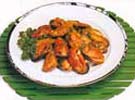|
|
Cuisine Glossary
| You have reached our International Cuisines and information on all aspects of a countries cuisine.
We will try to explain the culture, significant influences, climate, and other factors that have come together to create a distinct style. For example: Spanish, Mexican or Japanese. |
Bahamian Cuisine
 |
Although virtually any type of international food can be found in The Islands Of The Bahamas, it would be a mistake to miss an opportunity to sample the local cuisine. No matter where you are, you won't have any difficulty finding plenty of restaurants serving Bahamian cuisine and fresh local seafood at reasonable prices.
Seafood is the staple of the Bahamian diet. Conch (pronounced konk) is a large type of ocean mollusk that has firm, white, peach-fringed meat. Fresh, uncooked conch is delicious; the conch meat is scored with a knife, and lime juice and spices are sprinkled over the meat. It can also be deep-fried (called cracked conch), steamed, added to soups, salads and stews or made into conch chowder and conch fritters. The Bahamian rock lobster is a spiny variety without claws that is served broiled, minced or used in salads. Other delicacies include boiled or baked land crabs, which can be seen, before they are cooked, running across the roads after dark. Fresh fish also plays a major role in the cooking of The Islands Of The Bahamas -- a popular brunch is boiled fish served with grits, and when done right, is often the most flavourful way to enjoy the taste of a fresh catch. Stew fish, made with celery, onions, tomatoes and various spices, is another local specialty. Many dishes are accompanied by pigeon peas and rice (the infamous peas 'n' rice served throughout the Caribbean), with spices, tomatoes and onions. Peas also figure prominently in the wide array of fragrant Bahamian soups -- pea soup with dumplings and salt beef and the familiar split pea and ham soup are just two of the many pea-based broths. One soup unique to the Caribbean and Bahamas is the souse (pronounced sowse) -- the only ingredients are water, onions, lime juice, celery, peppers and meat; no thickeners are added. The meat added to a souse is often chicken, sheep's tongue, oxtail or pigs' feet -- giving the souse a delicious, rich flavor, new to many visitors. The cuisine of The Islands Of The Bahamas is never, ever bland. Spicy, subtly and uniquely flavored with local meats and produce, more than any other cuisine in the West Indies, Bahamian cooking has been influenced by the American South. One very popular example of this influence is the fish 'n' grits mentioned above. Both alcoholic and nonalcoholic drinks are a highly developed specialty in The Islands Of The Bahamas; bars pride themselves on their own special concoctions of rum punch. Kalik, the beer of The Islands Of The Bahamas, is unusually light and wheaty, served well-chilled to wash down the day's heat. The Bahamian refresher of choice is coconut water (not the heavier, fattier coconut milk) blended with sweet milk and gin. There is also a drink called Switcher, made with native limes; those who have had it swear that it tastes better than any other citrus drink. Source: HungryMonster Writers |




